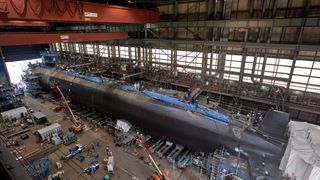Australia’s success preparing a highly-skilled, specialised industrial workforce will determine the future of AUKUS and Australia’s defence capability, a new report released by the United States Studies Centre (USSC) finds.
In AUKUS inflection point: Building the ecosystem for workforce development, lead authors Professor Peter Dean and Alice Nason evaluate what it will take for the Australian Government to deliver the sovereign fleet of nuclear-powered submarines outlined in the AUKUS ‘optimal pathway’ announcement.
“The challenge is immense, and Australia’s national workforce is, as yet, unprepared to meet it,” Professor Dean, Director of Foreign Policy and Defence says.
“Australia stands at an inflection point. The ability for the government to realise a 20,000-strong direct workforce to build and sustain the AUKUS submarines will determine the future of not only Australia’s defences, but its alliances and national economy for decades to come.”
After more than 40 engagements and interviews with experts and officials across the three AUKUS partners and through four unique case studies of rapid skilled industrial workforce development, the authors alongside research associates Sophie Mayo and Samuel Garrett, highlight the scale of the challenge at hand and propose six major recommendations for how it might be overcome.
“The AUKUS partnership is arguably the most ambitious capability program in Australian defence history. The findings in this report represent the starting point rather than the conclusion of a larger national conversation that must occur for AUKUS to deliver the opportunities promised,” added Research Associate Ms Nason.
The report emphasises that government’s ability to marshal workers for this enterprise swiftly is a test of political will, national capability and public resolve.
Key recommendations
- Increase public and stakeholder engagement and build the social license for the AUKUS partnership needed to attract and retain workers.
- Invest in and continually update a long-term national-level workforce plan to optimise future workforce productivity and account for current and projected demographic and skills problems.
- Elevate diversity as a strategic imperative across the AUKUS enterprise.
- Train and upskill Australian workers through dedicated and creative skills partnerships that seamlessly coordinate government and industry.
- Attract high-quality migrant workers to fill skills gaps in AUKUS-adjacent industries, increasing the available pool of talent in priority areas.
- Make versatility and adaptability intrinsic traits of the AUKUS workforce.
Media enquiries
USSC Media
T 0468 480 165
E ussc.media@sydney.edu.au





